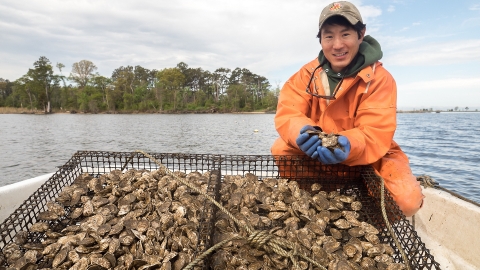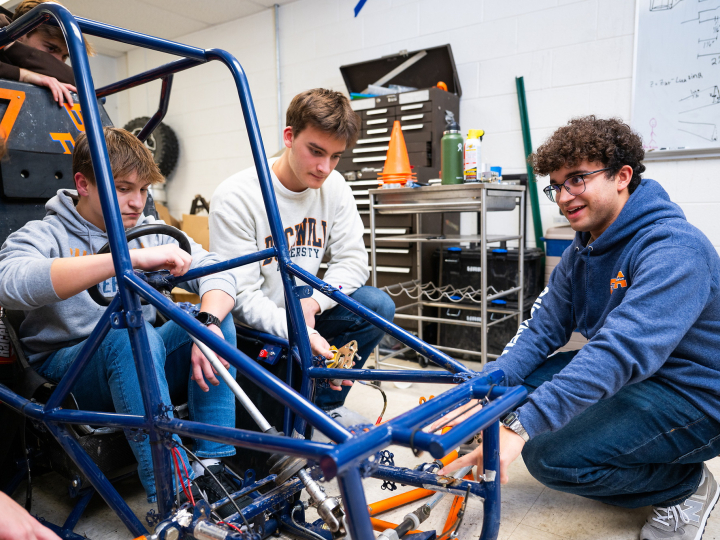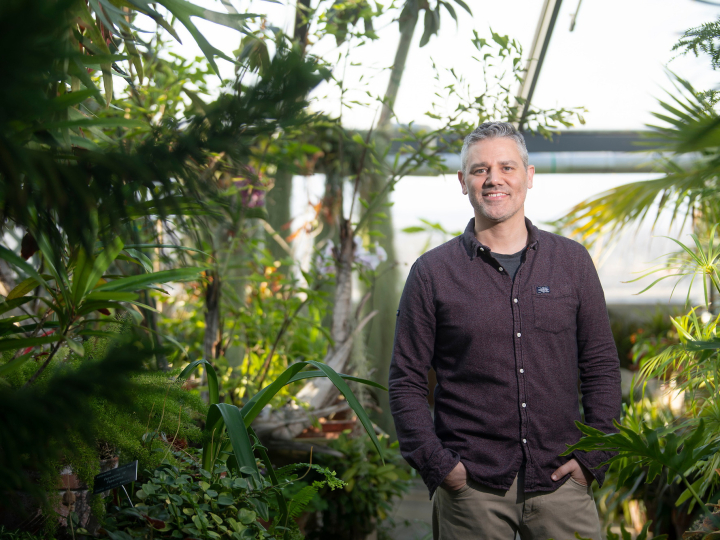
On Land & Sea
July 12, 2017
Scott Budden (pictured) and his cousin Dylan White work Budden's oyster lease in the Chester River. Photo by David Harp
Bucknellians employ environmentally sustainable practices to protect everything from apples to oysters.
By Christine Burns Rudalevige
"Farm-to-table" is a sizzling-hot movement that promises fresh, unprocessed, tasty, nutritious food brought to eaters from as near as the closest, sustainably minded farm. The USDA says the American local food market grew from $4.8 billion in 2008 to $6.1 billion in 2012 and to $11.7 in 2014. It's a maxim with many variations: farm-to-fork, trawl-to-table, farm-to-ladle, farm-to-school, pasture-to-plate, to name a few. But no matter how you turn this phrase, it continues to make cash registers sing from Berkeley to Boston, Austin to Anchorage.
But there is also a growing body of evidence concerning sustainable food production practices — the very ones used to satisfy the burgeoning locavore appetite — that demonstrate just how well they add up environmentally.
A host of cross-disciplined Bucknellians who are currently involved in agricultural enterprises tout the environmental merits of the sustainable practices they employ on their farms. But while the apple farmer, cheese maker, sheep breeder and oyster farmer featured below can wax scientifically poetic for hours about which heirloom apples make the best hard cider; how to tumble an oyster just so; the right technique to get a downy white rind on a Camembert-style cheese; and the interesting connection between Tunis sheep and some of America's founding fathers, they all speak more somberly about the minutiae of making their businesses economically, as well as environmentally, sustainable.
"A crucial measure of any sustainable farm is that it's still here next year to produce more food," says John Melick '93, a 10th-generation farmer whose family farm was founded in 1725 by German immigrants about 50 miles west of Manhattan in Bedminster, N.J. Melick says that even while studying at Bucknell and during his 10-year tenure as a civil engineer, he never really left the farm, as he still worked the land nights, weekends and summers.
Now the largest apple grower in New Jersey with more than 650 acres and 30,000 apple and 5,000 stone fruit trees, he's helped Melick's Town Farm develop a diversified sales and delivery strategy that sustains the operation's bottom line. It includes several brick-and-mortar stores selling fruit and vegetables, a healthy wholesale business that serves supermarkets and regional farm stores, a pick-your-own operation, a community-supported agriculture scheme, a farm winery specializing in hard cider and a regular farmers' market rotation.
While he tries to minimize their use, market standards for fruit makes it very tough for an operation of his size to quit pesticides whole hog. He can charge $1.99 per pound for perfect apples but barely earn 10 cents per pound for ones misshapen by fungus or disease.
Melick asserts that ugly apples are still edible apples, an argument reiterated by food waste reduction advocates at every turn, and says increasing their value was also the driving force behind the farm's on-site cider mill. Central to the mill is a traditional rack-and-cloth cider press used to make fresh cider from imperfect apples and hard cider from a mix of old- and new-world apple varieties specifically cultivated for their tannin level.
Melick used the civil-engineering skills he learned at Bucknell to design his heritage apple orchard with the varieties (Calville Blanc, Ashmead's Kernel, Chisel Jersey and Dabinett) he wants to use in future batches of hard cider. "It's exciting to plan how the heritage apples can play into the future of the farm," says Melick.
In order to cultivate a herd of dairy sheep naturally productive enough to make cheese a profitable venture on her Weston, Mo., farm, Sarah Hoffmann '80 had to deal with what she called a "limited genetics" issue.
Hoffmann, a chemistry major who graduated from medical school and pursued a career in infectious-disease research, purchased Green Dirt Farm in 1996 with husband John Spertus, a cardiologist. She started working the land full time in 2000, the first 12 sheep arrived in 2002, and she began milking the ladies in 2004. When the farm was licensed to make cheese four years later, Hoffmann made 800 pounds.
"We sold every bit of cheese we made in those early years, but we weren't even covering the fixed costs," says Hoffmann. "The science of the farm I could easily understand. The business end of the enterprise is one of those continuous learning curves."
She brought some cow's milk from neighboring farms into the mix and reduced her flock, keeping her best milkers. She wanted to cross those ewes with French Lacaune sheep, known as the Jerseys of the sheep world because their rich milk is perfect for cheese-making. But there are few Lacaune on this side of the Atlantic.
To get the "improved genetic material" (aka sperm) shipped to the United States, the Dairy Sheep Association of North America had to gain USDA approval. And to get that material deposited into her ewes, Hoffmann needed a one-time artificial insemination dispensation from A Greener World, a respected third-party auditor that certifies livestock is raised humanely and in an environmentally sustainable fashion.
She pays rigorous attention to how her flock grazes to maintain healthy soil and help nutritious pasture grasses thrive. The sheep rotate to a new grazing area every day. Pasture sections, which are divided by portable, solar-powered fences, rest for three months before the sheep revisit them. Hoffmann says carefully tended pastures make happy sheep that yield high-quality, flavorful milk, but she also knows the process prevents soil erosion and helps to build topsoil.
Hoffmann's farm produced 30,000 pounds of cheese last year, much of it award-winning and distributed nationally. She credits the mix of grasses and legumes her sheep eat, and honors the soil of the Missouri River Valley's rolling terrain and the sheep with cheese names like Dirt Lover (an ash-dusted French farmhouse cheese), Prairie Tomme (a long-aged, Alpine-style cheese) and Woolly Rind (a bloomy rind cheese).
Telling the story of where the food sitting on a customer's plate came from is one of the strongest tenets of farm-to-table marketing. Bucknell President Emeritus Gary Sojka recounts the history of the Tunis sheep that live on Bend in the Creek Farm with him and wife Sandy in Middleburg, Pa.
The first pair of Tunis sheep to set hoof in the United States were a gift to George Washington from the Bey of Tunis, monarch of Tunisia, in 1799. Washington entrusted Judge Richard Peters of Belmont, Pa., to cross the sheep with domesticated New World rams available at the time, resulting in one of the oldest breeds of livestock developed in America, explains Sojka, who has been raising Tunis sheep for more than 20 years. He does so to help preserve the endangered breed, since most of the Tunis sheep were eaten during the Civil War era. His herd stood at a low of 60 sheep this spring, but he wasn't too worried about his numbers, as 40 were pregnant.
Like Hoffmann, Sojka understands the atmospheric and ecological importance of fixing carbon from the air into the soil through rotational grazing regimens, which he practices religiously. But to leave that thriving underground carbon economy undisturbed, in more than 20 years Sojka has never broken the surface of the soil on any of his 17 acres of grass — or 38 acres of hay — except to pull up thistles, a tenacious weed the sheep don't like to eat. He overseeds — a process of spreading seed for disparate grasses over already established grass to give the sheep a salad bowl of greens on which to dine.
Tunis sheep, with their floppy ears, broad tails, cream-colored wool, cinnamon-red faces and legs and friendly disposition, are dual-purpose animals that produce fine wool and tasty meat. Sojka holds an annual community sheep shearing day every spring, sells the wool via the Amish wool pool, and has a long waiting list of local eaters willing to take the superfluous males off his hands for $150 per animal, a price he's left untouched for six years.
"But these sheep are also living, breathing, traveling manure spreaders that don't require fossil fuels," jokes Sojka, explaining that sheep droppings are spread efficiently around his pastures with two shakes of a lamb's tail.
As a microbiologist, Sojka is very concerned about agricultural waste runoff making its way into rivers, flowing through watersheds like the one his farm lies in, and out to the ocean where it can create dead zones.
To protect against any runoff from Bend in the Creek Farm ending up in the Chesapeake Bay by way of Middle Creek, he constructed a 100-yard riparian buffer comprising a fence, a swath of grass, a gravel path and a line of trees. The composite buffer sits between any pasture the sheep would frequent and the creek. Studies conducted by the USDA show that these buffers reduce nitrogen from agricultural runoff by 68 percent.
"Given our present light use of the land, that buffer will make sure not a drop of waste makes it to the creek," says Sojka. But thinking about future uses of the land, he adds, makes the measure a sustainable one.
In the world of sustainable agriculture, Sojka says he feels a bit disingenuous, since he and Sandy heavily subsidize their farm operations with their personal resources and take no compensation for their labor. "True sustainable farmers have to be economically as well as environmentally sustainable, which we obviously can't be with our principal aim being to conserve an important part of our nation's livestock heritage," says Sojka.
Just as Sojka works to limit agricultural waste making its way to the Chesapeake Bay, Scott Budden '07, owner of the most northerly oyster farm in the bay, has an opportunity to help the bay recover ecologically while feeding the public's ravenous appetite for local oysters. The Chesapeake used to be chockfull of oysters that could each filter 50 gallons of water a day, protecting the bay from being overrun with the microscopic algae oysters eat. But when these bivalves gained worldwide acclaim they were harvested and eaten into near extinction. Oyster farms are sustainable aquaculture's answer to restoring the ecological equilibrium of the bays up and down the East Coast.
Because Orchard Point Oyster Co. is near the mouth of the Chester River, it lies adjacent to the pristine waters of the Eastern Neck National Wildlife Refuge. Budden plants his oysters in off-bottom cages in a subtidal cove fed by a direct inlet to the bay, giving them a fresh supply of food and a salty flush twice daily. The result is an elegant oyster with a slightly briny start and a creamy, buttery finish.
But that's not to say Budden, who grew up along these same shores before earning a degree in economics and international relations, doesn't have to work 12- to 14-hour days to make his environmentally sustainable operation financially viable in the long term.
"With oysters, the more times you touch them from the time you plant them until they are big enough for you to plate them 18 months later, the better the end product is going to be," says Budden, who handles his oysters 12 to 15 times in that period, sorting them by size, tumbling them in plastic tubes to help their shells develop desirably deep cups, and cleaning them before delivering them to top Washington, D.C., restaurants. Budden, who was a financial analyst and business consultant in D.C. for eight years before turning to full-time oyster farming, harvested his first 40,000 oysters last fall, and the company is profitable — at least until something mechanical breaks, which occurs frequently, he says. His goal is to sell 1 million oysters annually within the next five years.
Given the culinary fervor for oysters and the net-positive environmental cost to produce them, Budden expects many more oyster farms to come online in the next five to 10 years.
"Yes, a rising tide is going to lift all ships, but I'm working like a dog to be on the ship with the most consistent supply of top-quality oysters available," says Budden. And then he'll still be in the black — even when something mechanical breaks."

